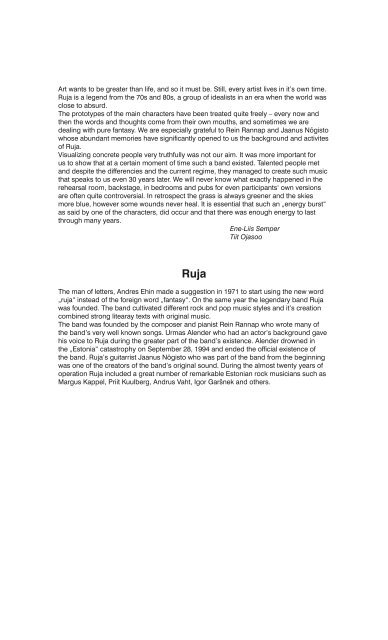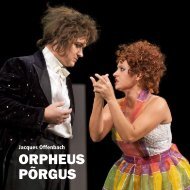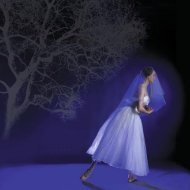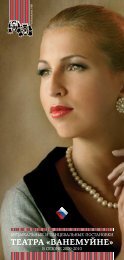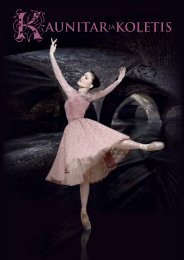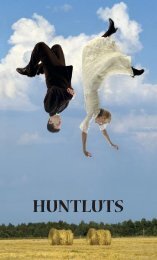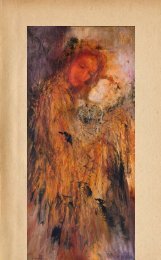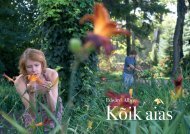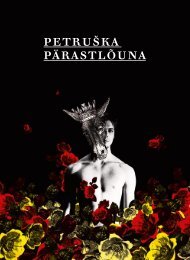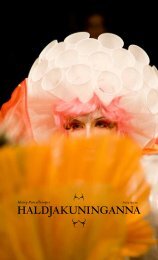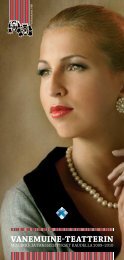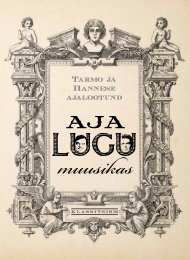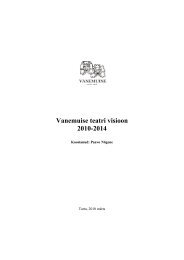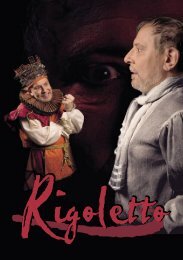Create successful ePaper yourself
Turn your PDF publications into a flip-book with our unique Google optimized e-Paper software.
Art wants to be greater than life, and so it must be. Still, every artist lives in it’s own time.<br />
<strong>Ruja</strong> is a legend from the 70s and 80s, a group of idealists in an era when the world was<br />
close to absurd.<br />
The prototypes of the main characters have been treated quite freely – every now and<br />
then the words and thoughts come from their own mouths, and sometimes we are<br />
dealing with pure fantasy. We are especially grateful to Rein Rannap and Jaanus Nõgisto<br />
whose abundant memories have significantly opened to us the background and activites<br />
of <strong>Ruja</strong>.<br />
Visualizing concrete people very truthfully was not our aim. It was more important for<br />
us to show that at a certain moment of time such a band existed. Talented people met<br />
and despite the differencies and the current regime, they managed to create such music<br />
that speaks to us even 30 years later. We will never know what exactly happened in the<br />
rehearsal room, backstage, in bedrooms and pubs for even participants‘ own versions<br />
are often quite controversial. In retrospect the grass is always greener and the skies<br />
more blue, however some wounds never heal. It is essential that such an „energy burst“<br />
as said by one of the characters, did occur and that there was enough energy to last<br />
through many years.<br />
Ene-Liis Semper<br />
Tiit Ojasoo<br />
<strong>Ruja</strong><br />
The man of letters, Andres Ehin made a suggestion in 1971 to start using the new word<br />
„ruja“ instead of the foreign word „fantasy“. On the same year the legendary band <strong>Ruja</strong><br />
was founded. The band cultivated different rock and pop music styles and it’s creation<br />
combined strong litearay texts with original music.<br />
The band was founded by the composer and pianist Rein Rannap who wrote many of<br />
the band’s very well known songs. Urmas Alender who had an actor’s background gave<br />
his voice to <strong>Ruja</strong> during the greater part of the band’s existence. Alender drowned in<br />
the „Estonia“ catastrophy on September 28, 1994 and ended the official existence of<br />
the band. <strong>Ruja</strong>’s guitarrist Jaanus Nõgisto who was part of the band from the beginning<br />
was one of the creators of the band’s original sound. During the almost twenty years of<br />
operation <strong>Ruja</strong> included a great number of remarkable Estonian rock musicians such as<br />
Margus Kappel, Priit Kuulberg, Andrus Vaht, Igor Garšnek and others.<br />
Tiit Ojasoo was born on August 28, 1977. In 2000 he graduated from the Estonian<br />
Academy of Music and Theatre theatre department, among the graduating class of 19.<br />
After graduation he worked in the Estonian Drama Theatre as director. In Spring 2004 he<br />
was elected the manager of Old Town Studio. Since 2005 Ojasoo is the artistic director<br />
and manager of Theatre NO99. Ojasoo has produced more than twenty productions<br />
in Endla Theatre, <strong>Vanemuine</strong> Theatre, Von Krahl Theatre, Estonian Drama Theatre and<br />
in NO99. In addition to drama productions, Ojasoo has also directed musicals: „Blood<br />
Brothers” and „Evita” in <strong>Vanemuine</strong>. The designer and in some cases co-director in most<br />
of his productions is Ene-Liis Semper.<br />
His productions have been invited to festivals in Russia, Lithuania, Poland, Germany,<br />
Finland, Austria and Switzerland.<br />
In Theatre NO99 Ojasoo has produced „Sometimes it feels that life is ending and<br />
there was no love at all”, „The Pillowman”, „Seven Samurai”, „Oil!”, „King Ubu”, „The<br />
Deerslayer”, „Totu on the Moon”, „HEG” and „Pericles”.<br />
Ene-Liis Semper was born on April 4, 1969. In 1995, Semper graduated from the Estonian<br />
Academy of Arts (EAA) majoring in scenography and has thereafter created more<br />
than seventy stage designs in addition to numerous costume designs in theatres all over<br />
Estonia. Futhermore, Semper has internationally been one of the best known Estonian<br />
artists during the past decade who has participated in many exhibitions, including the<br />
Venice Biennale, foremost with her video productions. Semper is also the author of<br />
several performancies.<br />
Since 2005, Semper is the artistic director of theatre NO99.<br />
After the graduation from the EAA, Semper has created stage designs in numerous<br />
theatres and for various directors. Long-time cooperations have developed with directors<br />
who are known for their innovative theatre language such as Mati Unt, Hendrik Toompere<br />
jr and Tiit Ojasoo. Her newest works are „The Death of the Communist” together with<br />
Hendrik Toompere and Shakespeare’s „Pericles” together with Tiit Ojasoo.<br />
Erki Pehk graduated from the Tallinn Conservatoire as choir conductor in 1993 in the<br />
class of professor Ants Üleoja. He studied orchestra conducting with Peeter Lilje, later<br />
under the instruction by Paul Mägi. He has taken supplementary courses in the Latvian<br />
Academy of Music during 1992-1994 and in the London Guildhall School of Music and<br />
Drama in 1997.<br />
Since 1994, he works in the Estonian National Opera. Also he has conducted several<br />
orchestras in Russia, Finland, the Ukraine, Latvia, France (incl. Estonian National<br />
Symphony Orchestra, Latvian National Orchestra, Tampere Philharmonic Orchestra,<br />
Moscow Helikon Opera Orchestra, Krasnojarsk Academical National Symphony<br />
Orchestra, Kievska Kamerata, Tallinn Chamber Orchestra, Pärnu City Orchestra, etc).<br />
In January 2000, he established the XXI Century Orchestra. Together with this project<br />
orchestra he has given more than 40 different concerts from baroque to pop music,<br />
recorded CDs and film music.<br />
Since the year 2001 he is the artistic director of the Klaudia Taev International<br />
Competition for Opera Singers. Since the year 2005 he is the artistic director of PromFest<br />
– the International Opera Music Festival in Pärnu. He has been the subscriber and the<br />
first presenter of several Estonian compositions.<br />
Palle Palmé is one of the most valued specialists in his field in Sweden. His most<br />
important works are: Loewe’s „My Fair Lady“, Webber’s „The Phantom of the Opera“,<br />
Porter’s „Kiss Me, Kate“, Kander’s „Cabaret“, Weill’s „The Threepenny Opera“, and Elton<br />
John & Tim Rice’s „Aida“. Palle Palmé has also worked as a light designer in the <strong>Vanemuine</strong>:<br />
Elton John & Tim Rice’s „Aida“, Webber’s „Jesus Christ Superstar“, Bernstein’s<br />
„West Side Story“, Webber`s „Cats“ and Styne`s „Sugar“. He has worked with the<br />
Cullberg Ballet. Palle Palmé was the light designer of the final concert of the Eurovision<br />
song contest held in Stockholm in 2000.


